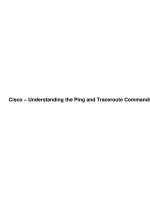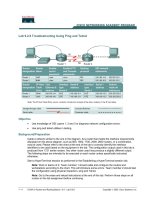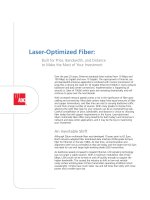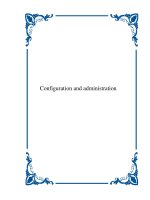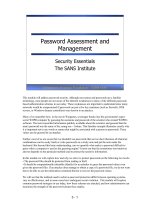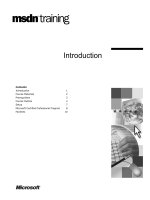ICMP: Ping and Trace ppt
Bạn đang xem bản rút gọn của tài liệu. Xem và tải ngay bản đầy đủ của tài liệu tại đây (423.48 KB, 27 trang )
ICMP: Ping and Trace
2
172.30.1.20 172.30.1.25
3
Ping
•
Uses ICMP message encapsulated within an IP Packet
–
Protocol field = 1
•
Both are layer 3 protocols. (ICMP is considered as
a network layer protocol.)
•
Does not use TCP or UDP, but may be acted upon by
the receiver using TCP or UDP.
Format
•
ping ip address (or ping <cr> for extended ping)
•
ping 172.30.1.25
Ethernet Header
(Layer 2)
IP Header
(Layer 3)
ICMP Message
(Layer 3)
Ether.
Tr.
Ethernet
Destination
Address
(MAC)
Ethernet
Source
Address
(MAC)
Frame
Type
Source IP Add.
Dest. IP Add.
Protocol field
Type
0 or 8
Code
0
Check-
sum
ID Seq.
Num.
Data FCS
4
Echo Request
•
The sender of the ping, transmits an ICMP message,
“Echo Request”
Echo Request - Within ICMP Message
•
Type = 8
•
Code = 0
Ethernet Header
(Layer 2)
IP Header
(Layer 3)
ICMP Message - Echo Request
(Layer 3)
Ether.
Tr.
Ethernet
Destination
Address
(MAC)
Ethernet
Source
Address
(MAC)
Frame
Type
Source IP
Add.
172.30.1.20
Dest. IP Add.
172.30.1.25
Protocol field
1
Type
8
Code
0
Check-
sum
ID Seq.
Num.
Data FCS
5
172.30.1.20 172.30.1.25
6
Echo Reply
•
The IP address (destination) of the ping,
receives the ICMP message, “Echo Request”
•
The ip address (destination) of the ping,
returns the ICMP message, “Echo Reply”
Echo Reply - Within ICMP Message
•
Type = 0
•
Code = 0
Ethernet Header
(Layer 2)
IP Header
(Layer 3)
ICMP Message - Echo Reply
(Layer 3)
Ether.
Tr.
Ethernet
Destination
Address
(MAC)
Ethernet
Source
Address
(MAC)
Frame
Type
Source IP
Add.
172.30.1.25
Dest. IP Add.
172.30.1.20
Protocol field
1
Type
0
Code
0
Check-
sum
ID Seq.
Num.
Data FCS
7
Q: Are pings forwarded by routers?
A: Yes! This is why you can ping devices all over
the Internet.
Q: Do all devices forward or respond to pings?
A: No, this is up to the network administrator of the
device. Devices, including routers, can be
configured not to reply to pings (ICMP echo
requests). This is why you may not always be able
to ping a device. Also, routers can be configured
not to forward pings destined for other devices.
Routers and Pings
8
Traceroute
•
Traceroute is a utility that records the route (router
IP addresses) between two devices on different networks.
9
Tracroute
•
/>•
On modern Unix and Linux-based operating systems, the
traceroute utility by default uses UDP datagrams with a
destination port number starting at 33434.
•
The traceroute utility usually has an option to specify
use of ICMP echo request (type 8) instead.
•
The Windows utility uses ICMP echo request, better known
as ping packets.
•
Some firewalls on the path being investigated may block
UDP probes but allow the ICMP echo request traffic to
pass through.
•
There are also traceroute implementations sending out TCP
packets, such as tcptraceroute or Layer Four Trace.
•
In Microsoft Windows, traceroute is named tracert.
•
A new utility, pathping, was introduced with Windows NT,
combining ping and traceroute functionality. All these
traceroutes rely on ICMP (type 11) packets coming back.
10
•
Trace ( Cisco = traceroute, tracert,…) is used to trace the
probable path a packet takes between source and
destination.
•
Probable, because IP is a connectionless protocol, and
different packets may take different paths between the same
source and destination networks, although this is not
usually the case.
•
Trace will show the path the packet takes to the
destination, but the return path may be different.
–
This is more likely the case in the Internet, and less likely within your own
autonomous system.
•
Linux/Unix Systems
–
Uses ICMP message within an IP Packet
–
Both are layer 3 protocols.
–
Uses UDP as a the transport layer.
–
We will see why this is important in a moment.
Trace (Traceroute)
11
Format (trace, traceroute, tracert)
•
RTA# traceroute ip address
RTA# traceroute 192.168.10.2
10.0.0.0/8 172.16.0.0/16 192.168.10.0/24
.1 .1 .1.2 .2 .2
RTA RTB RTC RTD
Trace
12
How it works (using UDP) - Fooling the routers & host!
•
Traceroute uses ping (echo requests)
•
Traceroute sets the TTL (Time To Live) field in the
IP Header, initially to “1”
10.0.0.0/8 172.16.0.0/16 192.168.10.0/24
.1 .1 .1.2 .2 .2
DA = 192.168.10.2, TTL = 1
RTA RTB RTC RTD
Data Link Header
(Layer 2)
IP Header
(Layer 3)
ICMP Message - Echo Request (trace) UDP
(Layer 4)
DataLink
Tr.
Data Link
Destination
Address
Data Link
Source
Address
……
Source IP
Add.
10.0.0.1
Dest. IP Add.
192.168.10.2
Protocol field
1
TTL
1
Type
8
Code
0
Chk
sum
ID Seq.
Num
Data
DestPort
35,000
FCS
Trace
13
RTB - TTL:
•
When a router receives an IP Packet, it decrements the TTL by 1.
•
If the TTL is 0, it will not forward the IP Packet, and send
back to the source an ICMP “time exceeded” message.
•
ICMP Message: Type = 11, Code = 0
10.0.0.0/8 172.16.0.0/16 192.168.10.0/24
.1 .1 .1.2 .2 .2
DA = 192.168.10.2, TTL = 1
ICMP Time Exceeded, SA = 10.0.0.2
RTA RTB RTC RTD
Data Link Header
(Layer 2)
IP Header
(Layer 3)
ICMP Message - Time Exceeded DataLink
Tr.
Data Link
Destination
Address
Data Link
Source
Address
….
Source IP
Add.
10.0.0.2
Dest. IP Add.
10.0.0.1
Protocol field
1
Type
11
Code
0
Chk
sum
ID Seq
.
Nu
m.
Data FCS
Trace
14
RTB
•
After the traceroute is received by the first router,
it decrements the TTL by 1 to 0.
•
Noticing the TTL is 0, it sends back a ICMP Time
Exceeded message back to the source, using its IP
address for the source IP address.
•
Router B’s IP header includes its own IP address
(source IP) and the sending host’s IP address (dest.
IP).
10.0.0.0/8 172.16.0.0/16 192.168.10.0/24
.1 .1 .1.2 .2 .2
DA = 192.168.10.2, TTL = 1
ICMP Time Exceeded, SA = 10.0.0.2
RTA RTB RTC RTD
Data Link Header
(Layer 2)
IP Header
(Layer 3)
ICMP Message - Time Exceeded DataLink
Tr.
Data Link
Destination
Address
Data Link
Source
Address
….
Source IP
Add.
10.0.0.2
Dest. IP Add.
10.0.0.1
Protocol field
1
Type
11
Code
0
Chk
sum
ID Seq
.
Nu
m.
Data FCS
15
RTA, Sending Host
•
The traceroute program of the sending host (RTA)
will use the source IP address of this ICMP Time
Exceeded packet to display at the first hop.
RTA# traceroute 192.168.10.2
Type escape sequence to abort.
Tracing the route to 192.168.10.2
1 10.0.0.2 4 msec 4 msec 4 msec
10.0.0.0/8 172.16.0.0/16 192.168.10.0/24
.1 .1 .1.2 .2 .2
DA = 192.168.10.2, TTL = 1
ICMP Time Exceeded, SA = 10.0.0.2
RTA RTB RTC RTD
Data Link Header
(Layer 2)
IP Header
(Layer 3)
ICMP Message - Time Exceeded DataLink
Tr.
Data Link
Destination
Address
Data Link
Source
Address
….
Source IP
Add.
10.0.0.2
Dest. IP Add.
10.0.0.1
Protocol field
1
Type
11
Code
0
Chk
sum
ID Seq
.
Nu
m.
Data FCS
16
RTA
•
The traceroute program increments the TTL by 1 (now
2 ) and resends the ICMP Echo Request packet.
Data Link Header
(Layer 2)
IP Header
(Layer 3)
ICMP Message - Echo Request (trace) UDP
(Layer 4)
DataLink
Tr.
Data Link
Destination
Address
Data Link
Source
Address
……
Source IP
Add.
10.0.0.1
Dest. IP Add.
192.168.10.2
Protocol field
1
TTL
2
Type
8
Code
0
Chk
sum
ID Seq.
Num
Data
DestPort
35,000
FCS
10.0.0.0/8 172.16.0.0/16 192.168.10.0/24
.1 .1 .1.2 .2 .2
DA = 192.168.10.2, TTL = 1
DA = 192.168.10.2, TTL = 2
ICMP Time Exceeded, SA = 10.0.0.2
RTA RTB RTC RTD
17
RTB
•
This time RTB decrements the TTL by 1 and it is NOT 0. (It is
1.)
•
So it looks up the destination ip address in its routing table
and forwards it on to the next router.
RTC
•
RTC however decrements the TTL by 1 and it is 0.
•
RTC notices the TTL is 0 and sends back the ICMP Time Exceeded
message back to the source.
•
RTC’s IP header includes its own IP address (source IP) and
the sending host’s IP address (destination IP address of RTA).
•
The sending host, RTA, will use the source IP address of this
ICMP Time Exceeded message to display at the second hop.
10.0.0.0/8 172.16.0.0/16 192.168.10.0/24
.1 .1 .1.2 .2 .2
DA = 192.168.10.2, TTL = 1
DA = 192.168.10.2, TTL = 2
ICMP Time Exceeded, SA = 10.0.0.2
ICMP Time Exceeded, SA = 172.16.0.2
RTA RTB RTC RTD
18
.
10.0.0.0/8 172.16.0.0/16 192.168.10.0/24
.1 .1 .1.2 .2 .2
DA = 192.168.10.2, TTL = 1
DA = 192.168.10.2, TTL = 2
ICMP Time Exceeded, SA = 10.0.0.2
ICMP Time Exceeded, SA = 172.16.0.2
RTA RTB RTC RTD
Data Link Header
(Layer 2)
IP Header
(Layer 3)
ICMP Message - Echo Request (trace) UDP
(Layer 4)
DataLink
Tr.
Data Link
Destination
Address
Data Link
Source
Address
……
Source IP
Add.
10.0.0.1
Dest. IP Add.
192.168.10.2
Protocol field
1
TTL
2
Type
8
Code
0
Chk
sum
ID Seq.
Num
Data
DestPort
35,000
FCS
Data Link Header
(Layer 2)
IP Header
(Layer 3)
ICMP Message - Echo Request (trace) UDP
(Layer 4)
DataLink
Tr.
Data Link
Destination
Address
Data Link
Source
Address
……
Source IP
Add.
10.0.0.1
Dest. IP Add.
192.168.10.2
Protocol field
1
TTL
1
Type
8
Code
0
Chk
sum
ID Seq.
Num
Data
DestPort
35,000
FCS
Data Link Header
(Layer 2)
IP Header
(Layer 3)
ICMP Message - Time Exceeded DataLink
Tr.
Data Link
Destination
Address
Data Link
Source
Address
….
Source IP
Add.
172.16.0.2
Dest. IP Add.
10.0.0.1
Protocol field
1
Type
11
Code
0
Chk
sum
ID Seq
.
Nu
m.
Data FCS
RTA to RTB
RTB to RTC
19
The sending host, RTA:
•
The traceroute program uses this information (Source
IP Address) and displays the second hop.
RTA# traceroute 192.168.10.2
Type escape sequence to abort.
Tracing the route to 192.168.10.2
1 10.0.0.2 4 msec 4 msec 4 msec
2 172.16.0.2 20 msec 16 msec 16 msec
10.0.0.0/8 172.16.0.0/16 192.168.10.0/24
.1 .1 .1.2 .2 .2
DA = 192.168.10.2, TTL = 1
DA = 192.168.10.2, TTL = 2
ICMP Time Exceeded, SA = 10.0.0.2
ICMP Time Exceeded, SA = 172.16.0.2
RTA RTB RTC RTD
Data Link Header
(Layer 2)
IP Header
(Layer 3)
ICMP Message - Time Exceeded DataLink
Tr.
Data Link
Destination
Address
Data Link
Source
Address
….
Source IP
Add.
172.16.0.2
Dest. IP Add.
10.0.0.1
Protocol field
1
Type
11
Code
0
Chk
sum
ID Seq
.
Nu
m.
Data FCS
20
The sending host, RTA:
•
The traceroute program increments the TTL by 1 (now
3 ) and resends the Packet.
Data Link Header
(Layer 2)
IP Header
(Layer 3)
ICMP Message - Echo Request (trace) UDP
(Layer 4)
DataLink
Tr.
Data Link
Destination
Address
Data Link
Source
Address
……
Source IP
Add.
10.0.0.1
Dest. IP Add.
192.168.10.2
Protocol field
1
TTL
3
Type
8
Code
0
Chk
sum
ID Seq.
Num
Data
DestPort
35,000
FCS
10.0.0.0/8 172.16.0.0/16 192.168.10.0/24
.1 .1 .1.2 .2 .2
DA = 192.168.10.2, TTL = 1
DA = 192.168.10.2, TTL = 2
DA = 192.168.10.2, TTL = 3
ICMP Time Exceeded, SA = 10.0.0.2
ICMP Time Exceeded, SA = 172.16.0.2
RTA RTB RTC RTD
21
.
Data Link Header
(Layer 2)
IP Header
(Layer 3)
ICMP Message - Echo Request (trace) UDP
(Layer 4)
DataLink
Tr.
Data Link
Destination
Address
Data Link
Source
Address
……
Source IP
Add.
10.0.0.1
Dest. IP Add.
192.168.10.2
Protocol field
1
TTL
2
Type
8
Code
0
Chk
sum
ID Seq.
Num
Data
DestPort
35,000
FCS
Data Link Header
(Layer 2)
IP Header
(Layer 3)
ICMP Message - Echo Request (trace) UDP
(Layer 4)
DataLink
Tr.
Data Link
Destination
Address
Data Link
Source
Address
……
Source IP
Add.
10.0.0.1
Dest. IP Add.
192.168.10.2
Protocol field
1
TTL
1
Type
8
Code
0
Chk
sum
ID Seq.
Num
Data
DestPort
35,000
FCS
10.0.0.0/8 172.16.0.0/16 192.168.10.0/24
.1 .1 .1.2 .2 .2
DA = 192.168.10.2, TTL = 1
DA = 192.168.10.2, TTL = 2
DA = 192.168.10.2, TTL = 3
ICMP Time Exceeded, SA = 10.0.0.2
ICMP Time Exceeded, SA = 172.16.0.2
RTA RTB RTC RTD
Data Link Header
(Layer 2)
IP Header
(Layer 3)
ICMP Message - Echo Request (trace) UDP
(Layer 4)
DataLink
Tr.
Data Link
Destination
Address
Data Link
Source
Address
……
Source IP
Add.
10.0.0.1
Dest. IP Add.
192.168.10.2
Protocol field
1
TTL
3
Type
8
Code
0
Chk
sum
ID Seq.
Num
Data
DestPort
35,000
FCS
RTA to RTB
RTB to RTC
RTC to RTD
22
RTB
•
This time RTB decrements the TTL by 1 and it is NOT 0. (It is 2.)
•
So it looks up the destination ip address in its routing table and
forwards it on to the next router.
RTC
•
This time RTC decrements the TTL by 1 and it is NOT 0. (It is 1.)
•
So it looks up the destination ip address in its routing table and
forwards it on to the next router.
RTD
•
RTD however decrements the TTL by 1 and it is 0.
•
However, RTD notices that the Destination IP Address of 192.168.0.2
is it’s own interface.
•
Since it does not need to forward the packet, the TTL of 0 has no
affect.
10.0.0.0/8 172.16.0.0/16 192.168.10.0/24
.1 .1 .1.2 .2 .2
DA = 192.168.10.2, TTL = 1
DA = 192.168.10.2, TTL = 2
DA = 192.168.10.2, TTL = 3
ICMP Time Exceeded, SA = 10.0.0.2
ICMP Time Exceeded, SA = 172.16.0.2
RTA RTB RTC RTD
23
RTD
•
RTD sends the packet to the UDP process.
•
UDP examines the unrecognizable port number of
35,000 and sends back an ICMP Port Unreachable
message to the sender, RTA, using Type 3 and Code 3.
Data Link Header
(Layer 2)
IP Header
(Layer 3)
ICMP Message – Port Unreachable DataLink
Tr.
Data Link
Destination
Address
Data Link
Source
Address
….
Source IP
Add.
192.168.10.2
Dest. IP Add.
10.0.0.1
Protocol field
1
Type
3
Code
3
Chk
sum
ID Seq
.
Nu
m.
Data FCS
Data Link Header
(Layer 2)
IP Header
(Layer 3)
ICMP Message - Echo Request (trace) UDP
(Layer 4)
DataLink
Tr.
Data Link
Destination
Address
Data Link
Source
Address
……
Source IP
Add.
10.0.0.1
Dest. IP Add.
192.168.10.2
Protocol field
1
TTL
1
Type
8
Code
0
Chk
sum
ID Seq.
Num
Data
DestPort
35,000
FCS
24
Sending host, RTA
•
RTA receives the ICMP Port Unreachable message.
•
The traceroute program uses this information (Source IP
Address) and displays the third hop.
•
The traceroute program also recognizes this Port
Unreachable message as meaning this is the destination it
was tracing.
10.0.0.0/8 172.16.0.0/16 192.168.10.0/24
.1 .1 .1.2 .2 .2
DA = 192.168.10.2, TTL = 1
DA = 192.168.10.2, TTL = 2
DA = 192.168.10.2, TTL = 3
ICMP Time Exceeded, SA = 10.0.0.2
ICMP Time Exceeded, SA = 172.16.0.2
ICMP Port Unreachable, SA = 192.168.10.2
RTA RTB RTC RTD
Data Link Header
(Layer 2)
IP Header
(Layer 3)
ICMP Message – Port Unreachable DataLink
Tr.
Data Link
Destination
Address
Data Link
Source
Address
….
Source IP
Add.
192.168.10.2
Dest. IP Add.
10.0.0.1
Protocol field
1
Type
3
Code
3
Chk
sum
ID Seq
.
Nu
m.
Data FCS
25
10.0.0.0/8 172.16.0.0/16 192.168.10.0/24
.1 .1 .1.2 .2 .2
DA = 192.168.10.2, TTL = 1
DA = 192.168.10.2, TTL = 2
DA = 192.168.10.2, TTL = 3
ICMP Time Exceeded, SA = 10.0.0.2
ICMP Time Exceeded, SA = 172.16.0.2
ICMP Port Unreachable, SA = 192.168.10.2
RTA RTB RTC RTD
Sending host, RTA
•
RTA, the sending host, now displays the third hop.
•
Getting the ICMP Port Unreachable message, it knows this
is the final hop and does not send any more traces (echo
requests).
RTA# traceroute 192.168.10.2
Type escape sequence to abort.
Tracing the route to 192.168.10.2
1 10.0.0.2 4 msec 4 msec 4 msec
2 172.16.0.2 20 msec 16 msec 16 msec
3 192.168.10.2 16 msec 16 msec 16 msec

